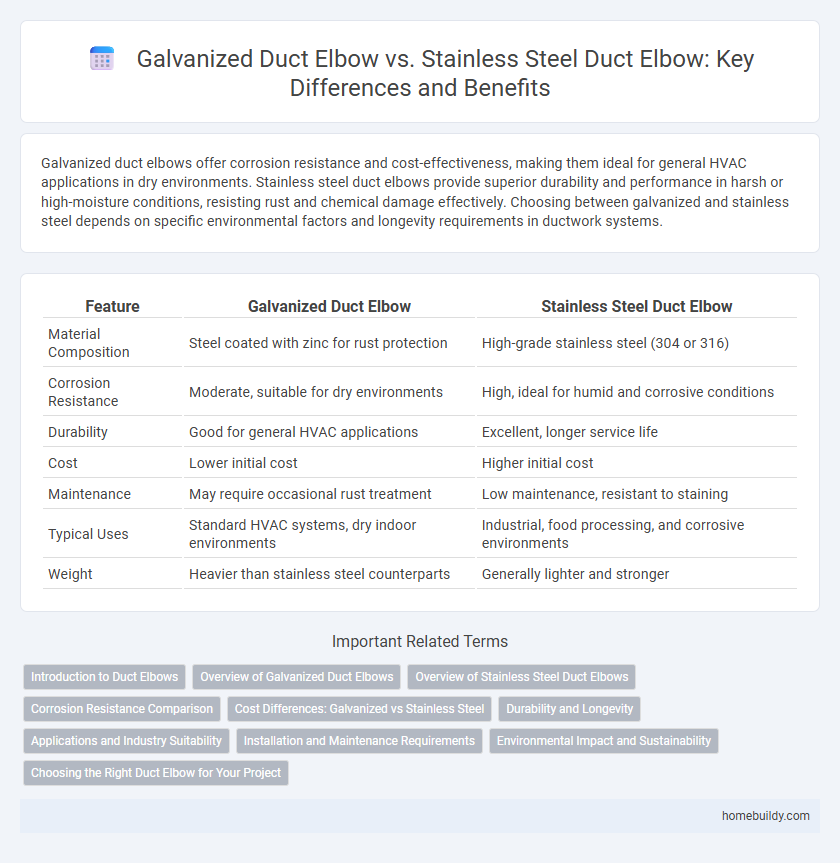Galvanized duct elbows offer corrosion resistance and cost-effectiveness, making them ideal for general HVAC applications in dry environments. Stainless steel duct elbows provide superior durability and performance in harsh or high-moisture conditions, resisting rust and chemical damage effectively. Choosing between galvanized and stainless steel depends on specific environmental factors and longevity requirements in ductwork systems.
Table of Comparison
| Feature | Galvanized Duct Elbow | Stainless Steel Duct Elbow |
|---|---|---|
| Material Composition | Steel coated with zinc for rust protection | High-grade stainless steel (304 or 316) |
| Corrosion Resistance | Moderate, suitable for dry environments | High, ideal for humid and corrosive conditions |
| Durability | Good for general HVAC applications | Excellent, longer service life |
| Cost | Lower initial cost | Higher initial cost |
| Maintenance | May require occasional rust treatment | Low maintenance, resistant to staining |
| Typical Uses | Standard HVAC systems, dry indoor environments | Industrial, food processing, and corrosive environments |
| Weight | Heavier than stainless steel counterparts | Generally lighter and stronger |
Introduction to Duct Elbows
Duct elbows are essential components in HVAC systems, enabling smooth changes in airflow direction while minimizing pressure loss. Galvanized duct elbows, coated with zinc for corrosion resistance, are widely used for their cost-effectiveness and durability in general applications. Stainless steel duct elbows offer superior corrosion resistance and strength, making them ideal for environments exposed to moisture, chemicals, or extreme temperatures.
Overview of Galvanized Duct Elbows
Galvanized duct elbows are constructed from steel coated with a layer of zinc, providing excellent resistance to rust and corrosion in HVAC applications. They are widely used for their cost-effectiveness and durability in both residential and commercial ductwork systems. Compared to stainless steel duct elbows, galvanized options offer good protection but may lack the same level of strength and longevity, especially in highly corrosive environments.
Overview of Stainless Steel Duct Elbows
Stainless steel duct elbows offer superior corrosion resistance and durability compared to galvanized duct elbows, making them ideal for harsh or corrosive environments. They maintain structural integrity under high temperatures and resist rust, which extends the lifespan of HVAC systems. Stainless steel's smooth surface also reduces airflow friction, improving overall system efficiency.
Corrosion Resistance Comparison
Galvanized duct elbows offer moderate corrosion resistance due to their zinc coating, which protects against rust and corrosion in environments with low to moderate moisture levels. Stainless steel duct elbows provide superior corrosion resistance by utilizing alloys such as chromium and nickel, making them ideal for harsh environments with high humidity, chemical exposure, or outdoor applications. The choice between galvanized and stainless steel duct elbows depends on the specific environmental conditions and longevity requirements of the duct system.
Cost Differences: Galvanized vs Stainless Steel
Galvanized duct elbows typically cost 30% to 50% less than stainless steel duct elbows due to the lower material and manufacturing expenses associated with galvanized steel. Stainless steel duct elbows offer superior corrosion resistance and durability, which justifies their higher price in environments requiring enhanced longevity and hygiene standards. Cost considerations for galvanized versus stainless steel duct elbows often center on the balance between initial investment and long-term maintenance savings.
Durability and Longevity
Galvanized duct elbows offer good corrosion resistance due to their zinc coating, making them suitable for indoor HVAC systems with moderate moisture exposure. Stainless steel duct elbows provide superior durability and longevity, with excellent resistance to rust, high temperatures, and harsh environmental conditions, ideal for industrial or outdoor applications. The extended lifespan of stainless steel duct elbows often justifies their higher initial cost compared to galvanized options.
Applications and Industry Suitability
Galvanized duct elbows are widely used in HVAC systems, ventilation, and industrial exhaust applications due to their cost-effectiveness and corrosion resistance in moderate environments. Stainless steel duct elbows are preferred in industries requiring high durability and resistance to extreme conditions, such as chemical processing, food production, and pharmaceutical manufacturing. Selecting between galvanized and stainless steel duct elbows depends on factors like environmental exposure, regulatory standards, and longevity requirements.
Installation and Maintenance Requirements
Galvanized duct elbows offer easier installation due to their lighter weight and compatibility with standard sheet metal tools, reducing labor time. Stainless steel duct elbows require skilled handling and specialized tools for welding or fastening, increasing installation complexity but providing superior corrosion resistance. Maintenance of galvanized elbows involves periodic inspection for rust and repainting, while stainless steel elbows demand minimal upkeep, primarily cleaning to prevent surface staining under harsh environments.
Environmental Impact and Sustainability
Galvanized duct elbows typically have a higher environmental impact due to the zinc coating process, which can release hazardous pollutants during production and disposal, whereas stainless steel duct elbows offer greater sustainability with their longer lifespan, recyclability, and resistance to corrosion without toxic coatings. Stainless steel duct elbows reduce waste and energy consumption over time due to durability and minimal need for replacement. Choosing stainless steel supports sustainable building practices by lowering the carbon footprint associated with ductwork maintenance and material degradation.
Choosing the Right Duct Elbow for Your Project
Galvanized duct elbows offer excellent corrosion resistance and affordability, making them ideal for HVAC systems in residential or commercial applications where cost efficiency is a priority. Stainless steel duct elbows provide superior durability and resistance to high temperatures, chemicals, and moisture, suitable for industrial environments and projects requiring long-term performance and hygiene. Selecting the right duct elbow depends on factors such as environmental conditions, budget constraints, and the specific requirements of airflow efficiency and maintenance.
Galvanized duct elbow vs stainless steel duct elbow Infographic

 homebuildy.com
homebuildy.com